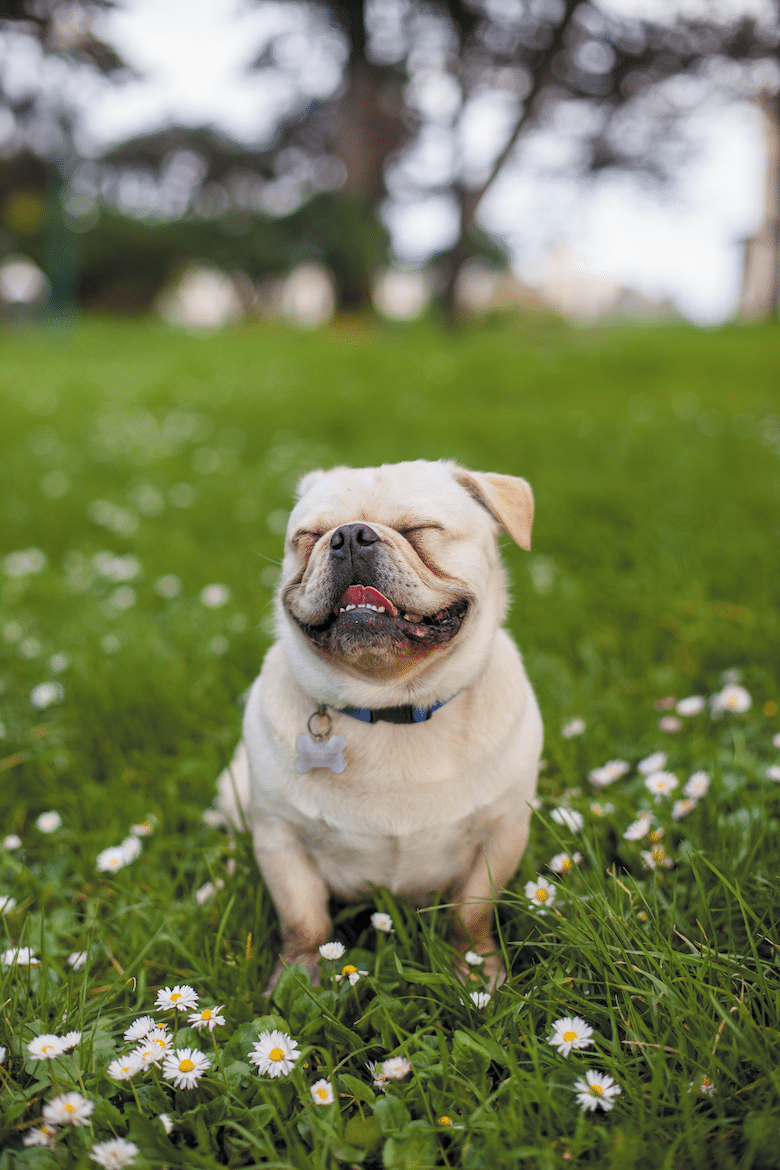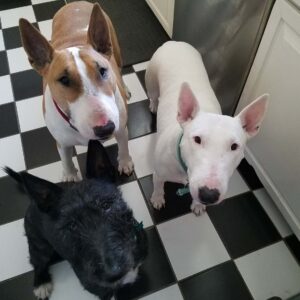Dogs don’t have job drama, childcare issues or any of the typical stressors that affect us humans. But they may have external or behavioral triggers that can cause anxiety, or just make them less easygoing, less relaxed and, well, less Zen.
Not surprisingly, whether your dog is Zen or not often is the result of reacting to you and the world around him. The first stage of owner enlightenment is to understand what a happy, calm and healthy dog looks like. There are typically both physical and behavioral signs.
Is your dog happy?
Steven Appelbaum gives this overview: “Although physical manifestations of calmness may differ slightly from breed to breed, generally a healthy dog has a shiny coat, bright and alert eyes and an energetic disposition,” says the founder and president of Animal Behavior College in Valencia, California. “Happy, calm dogs exhibit either neutral or friendly body posture around people and other dogs.”
Dr. Rachel Barrack, a certified veterinary acupuncturist and Chinese herbalist, echoes stance as an indicator. “Body language plays a large part in assessing a dog’s happiness,” says Dr. Barrack, founder of Animal Acupuncture in New York City. “Happy dogs are calm with an overall relaxed demeanor from head to tail.
Happy dogs wag their tails in a way that involves their whole body. A stiff tail wag without shaking the rest of the body typically occurs when your dog is assessing a new situation. A tail pinned underneath the body is a sign of fear. A happy dog’s ears are relaxed and not pinned back, which is a sign of aggression. Happy dogs may even fully relax their mouths, which can resemble a smile. Do not confuse this with panting, however, as that is indicative of overheating or stress.”
Dogs’ eating and pooping, as well as energy level, can be indicators of their current states, as well. “Their poops would be normal 99% of the time, they would not be excessively drinking water or excessively panting,” says Julie Anne Lee, who has a diploma in classical homeopathy and is the owner of Adored Beast Apothecary, a holistic veterinary clinic in Canada. “They would have abundant energy while playing, and be calm and relaxed while sleeping.”
Behavioral signs do manifest physically but in a different way. “Happy dogs are less likely to engage in destructive behaviors because they receive ample physical and mental stimulation,” Dr. Barrack says.
“Excessive chewing and other destructive behaviors, especially when exhibited suddenly in adult dogs, are signs of boredom, stress and unhappiness. All dogs slow down a bit with age, but happy, healthy dogs of any age enjoy walks and playtime. If your dog suddenly seems unwilling to engage or is unusually quiet, contact your veterinarian to rule out an underlying health cause.” This also applies to a sudden change in appetite.
Dr. Lee points out that with some behaviors, the problem lies with humans, not dogs. “For example, dogs sniff bums and when we are embarrassed and make them stop, we are removing an important aspect of how they sense if someone is safe,” she says. “Another thing is play; we have been forcing dogs to be so urbanized that even when seeing their leash excites them, many people try to calm that enthusiasm because they live in an apartment or feel it is too over the top when it’s the highlight of their dog’s day. We try to keep our dogs from barking or jumping too much, and they are not allowed to just be dogs.”
Angela Ardolino, who operates Fire Flake Farm, a rescue farm in Lutz, Florida, offers a reminder that all dogs are different, and some may have different issues that may just be part of that dog. “Sometimes you can do all the right things, but because of in-breeding, genetics, past abuse or mental illness, your dog will always have physical or behavioral issues.”
Another difference for dogs is their approach to Zen living and life in general. Misti Dian, director of Holistic Leadership for Radiant Health Institute in Nashville, Tennessee, points out that even for people being Zen is achievement based. “What if it wasn’t about becoming anything? What if it’s about a practice of being in the now, in the present moment? If you didn’t realize it already, your dog already knows this. Dogs only live in the present moment, and they’re begging us to join them every day.”
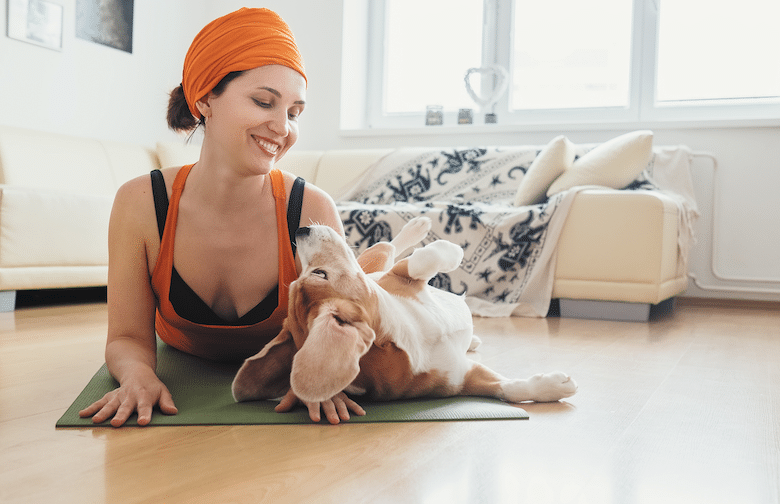
Routines or in the now?
Dogs live in the moment, but they also strive for routine. These might sound contradictory, but experts give tips on how to incorporate both for your dog’s peace of mind on a daily basis.
Related: How to Create the Perfect Daily Routine for Your Dog
“When dogs are involved in an activity, their whole attention is on it,” says Dr. Nancy Scanlan, a certified veterinary acupuncturist and student services manager at the College of Integrative Veterinary Therapies in Sydney, Australia. “For a dog, living in the moment means intense focus on whatever is on his mind. Routine is a schedule of things to do. Each thing on the schedule will get his focus at the time it is scheduled.”
And that focus may start even before the activity itself. “It is something for him to think about and anticipate rather than chewing on a door or escaping under the fence,” Dr. Scanlan says. “The less he has to do, the less pleasant things to anticipate, the more his actions will be channeled into destructive behavior — destructive to the house and to himself.”
Steven emphasizes the benefits of consistency when training. “Generally, you can think of dogs living in the moment and striving for routines/patterns they enjoy,” he says. “The last part is important when training. The more positively a dog associates a training routine, the more she will strive for it. This can mean anything from learning to travel safely in an automobile to obedience and to how to greet guests.”
And “in the moment” shouldn’t be taken too literally, points out L. Leigh Love, an Asheville, North Carolina-based animal intuitive, who helps owners enhance their relationships with their animal companions.
“Living in the moment for a dog actually includes more than just the immediate moment,” she says. “It covers their day and environment. We, as humans, tend to put more attention on past and future events. But, dogs do think about things in their immediate environment like when is the next meal, playtime, outside time, games and interaction with you. The structure of a routine helps them know what is coming and what to expect. It decreases stress and anxiety.”
A dog-like attitude to focusing on the present could help pets and people alike. “To live in the moment with your dog we need to learn from them,” Dr. Lee says. “I used to ask my clients, ‘The next time you are on Facebook posting pictures or quotes of how much you love your dog, stop to take 15 minutes … to show your dog your love, not the world how much you love your dog.’ ”
We all know life happens, which can disrupt everyone’s routine. When it comes to dogs, the types — and frequency — of deviations can make a difference in their Zen levels.
“Just like people, each dog has her own personality and needs, and the amount of routine needs will vary,” says Leigh, who is also a certified intuitive counselor and life coach, and organizer of the Angel Pets Expo.
“Small deviations shouldn’t cause a huge problem. Large deviations (i.e., not being let out for 12 hours or not being fed for a whole day) usually trigger anxiety and/or behavioral issues.”
Angela agrees and adds, “That does not mean that you can never change your routine, just that you should be mindful of your pets when you do.”
Dr. Scanlan says that the most important things to schedule are feeding time and walking/peeing/pooping time. “If he is not walked at his normal time he may urinate or defecate in the house, and it is not because he is mad at you, it is because he actually could not hold it anymore,” she says.
Dr. Lee has a different approach when it comes to chow time. “I feed my dogs when I eat because they are part of my family; I am part of their pack. If you have a routine feeding time and then come out of it, that is going to be really stressful because food is very important for them. But if they are just used to eating when you eat, that will be their routine rather than specific times.”
Food and consistency go paw-in-paw in another area of well-being. Leigh reminds owners to be consistent with rules. “For example, when we cave and break our own rule of no begging and give them food from the table, dogs learn that the rules aren’t really rules,” she says. “This encourages the dog to persist or see if they can get what they want. It becomes a game. Then it adds to their stress and confusion when they are yelled at or reprimanded for only doing what got them a treat previously.”
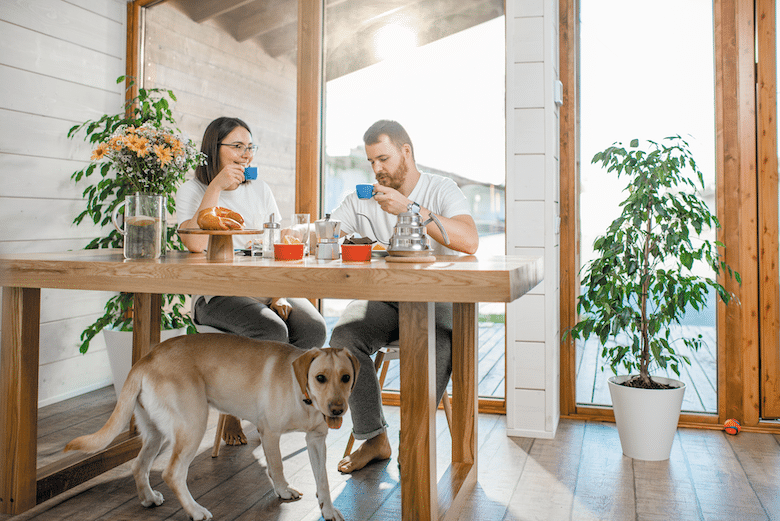
Part of the family routine
Routine can be a synonym for boring, but it doesn’t have to be. Think of routines as fun activities scheduled to happen for just you and your dog, the whole family or even the community.
“Every family is different, and every dog is different, but including them in your routine will give them an overall better sense of well-being,” Angela says.
Dr. Lee gives a couple ways to include your dog in the family’s routine. “For example, if soccer practice is at 7 every Wednesday night, bring your dog if they can come to practice. Don’t leave your dog alone for another 4 hours when you have left him alone all day. It may mean you include your dog in bedtime routines or story time with your children. Basically, and most importantly, include them as much as possible in your everyday life.”
Doug Kraus, of Santa Ana, California, includes one of his dogs in his own workout. “I do yoga on the floor and then play with Bruno at the same time hiding a ball under me while I do different poses,” Doug says. “Or I put the ball on my back while I do a plank or downward dog and he climbs up on me trying to find it. It’s a very interactive activity, and he just absolutely loves it.”
Mundane tasks can be converted into bonding activities. “If you make your dog do something before giving him a snack, even if it is just to sit or shake hands, this is more enjoyable for him,” Dr. Scanlan says. “You have changed from a food dispenser to somebody who will interact with him.”
You can even arrange for your dog to take on some special canine civic duties. “Enroll your dog for Animal Assisted Activities, which are typically in a hospital, nursing home or therapy center,” Dr. Barrack suggests. “If your pet is well-behaved he can be enrolled in these programs used to encourage socialization and optimize mental health. This can be a fun, feel-good way for the whole family to ‘give back.’”
And that’s something that can showcase a dog’s inherent “Zen-dencies.” “Therapy dogs spend their days ‘simply being’ as a way to serve those who suffer from panic, anxiety or illness,” Misti says. “They knew the secret long before we did — service is the key to feeling purpose and peace.”
Then there’s the non-active activities that relax your dog and boost your bond. “Just being together means a lot to a dog,” Leigh says. “A happy, well-balanced dog knows they are part of the family and cared for. Doing things like brushing them, talking to them and the Tellington T-touch, small gentle circular touches, are effective and easy to learn. Another great interaction is to sing to them. All animals love being sung to. They will feel the love and the heartfelt connection.”
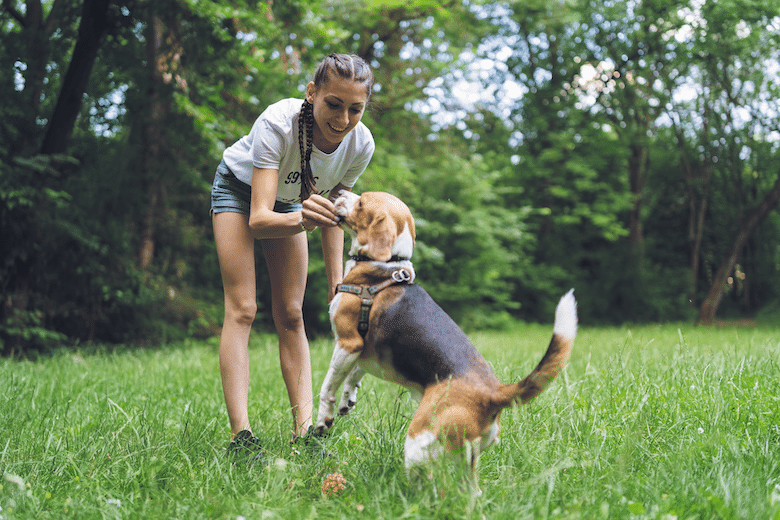
Exercise for body & mind
One of the ways to increase your dog’s Zen quotient is good, old-fashioned exercise. Not surprisingly, dogs get many benefits from being on the move. “I have lost count of the number of clients I’ve worked with over the years who came to me with various behavioral challenges that were either alleviated or eliminated completely by a consistent exercise program with their dog,” Steven says.
And it can even be something as simple as a walk. But your dog doesn’t have your goal of getting a certain amount of steps in each day. As Steven points out, “There is a big difference between walking the dog around the block and taking the dog for a long meandering walk in the mountains or anywhere in the country with new, intriguing sights and smells.”
Related: Doga, or Yoga for Dogs, Is Coming to a Studio Near You
Our dogs live in a world where their sense of smell is thousands of times greater than ours, Leigh adds. “Sniffing on walks is also considered fun for them.”
A common question when it comes to exercise for dogs is how often and just plain how. The equally common answer is “it depends.” “Different-sized dogs will need different amounts of exercise, but you should allow your dog to exercise and play as much as possible,” Angela says. “Exercising your dog doesn’t have to take hours and hours. But you should understand your dog’s breed and learn the types of activities that breed instinctively does. For example, if a breed is meant to herd, then you can try different herding activities outside like running and playing with a ball. It is really all about the quality of play, though, no matter what you are doing. The best activities are ones that engage your dog on multiple levels including physically, socially and mentally.”
Leigh agrees: “Playtime and socializing are fun and add enjoyment to your dog’s life. They also add to intellectual stimulation and decrease boredom. Socialization helps increase confidence, decrease fear and provides a sense of security and kinship.”
Another bonus? All that activity can help Sassy sleep better. “Sleep quality is usually related to physical health, although environmental factors must be considered,” Steven says. “A healthy, happy, physically conditioned dog will usually sleep well.”
And don’t make exercise stressful for either of you. “It doesn’t have to be boot camp,” Steven adds. “Make it fun.”
Fun is different for each dog. Consider Mean Girls’ Regina George, who insisted her friend “stop trying to make fetch happen.” Your dog may feel the same way. There are numerous fitness activities that your dog might find more enjoyable. Here are just a few:
- Agility training
- Doggie day care
- Doga(doggie yoga)
- Flyball
- Treats hidden around the house
- Kayaking
- Lure coursing
- Obedience training
- Swimming
- Scenting and tracking
- Treat puzzle toys
And if fetch is your dog’s thing, there’s more than one way to throw a ball. There are numerous ball-launching products, manual or automatic, that keep your dog on the move and your arm in its socket. There are also Frisbees and discs, which don’t use a ball at all.
By working together, you and your dog can show each other how you can be your most Zen selves. “Just because they cannot verbalize as we can, our pups show us all the time how to slow down and pay attention to what really matters,” Misti concludes. “We talk about being Zen; our pets embody it every single day. What could be more Zen than that?”
Top photograph:Mark Rodgers photography

